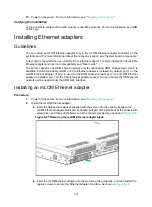
6-6
•
Log in to HDM to verify that the power supply is operating correctly. For more information, see
HDM online help.
Installing riser cards and PCIe modules
The server provides two PCIe riser connectors on the system board to install the riser cards for PCIe
module expansion. For more information about the connector locations, see "System board
components."
Guidelines
•
You can install a small-sized PCIe module in a large-sized PCIe slot. For example, an LP PCIe
module can be installed in an FHFL PCIe slot.
•
A PCIe slot can supply power to the installed PCIe module if the maximum power consumption
of the module does not exceed 75 W. If the maximum power consumption exceeds 75 W, a
power cord is required. Only the GPU-M4000-1-X GPU module requires a power cord.
For more information about connecting the power cord, see "
Connecting the power cord of a
•
For more information about PCIe module and riser card compatibility, see "Riser cards."
Procedure
The riser card installation procedure is the same for PCIe riser connectors 1 and 2. This procedure
uses PCIe riser connector 1 as an example.
To install a riser card and PCIe module:
1.
Power off the server. For more information, see "
2.
Remove the server from the rack. For more information, see "
Removing the server from a rack
."
3.
Remove the access panel. For more information, see "
."
4.
If a fastening screw retains a PCIe module blank on the riser card, remove and then re-install
that screw as follows:
a.
Open the retaining latch on the riser card and then remove the fastening screw, as shown
in
Figure 6-10 Removing the fastening screw from the riser card
b.
Remove the PCIe module blank and re-install the fastening screw upside down, as shown
in






























